lynnb
Mentor
In 1979 I travelled overseas for the first time. It was an impulsive trip - I was on my lunch break and when I saw cheap airfares to the US in a travel agent’s window (AUD$399 return) I bought a return ticket to LA on the spot, flying Pan Am. It was an easy decision as I had always wanted to see the major US national parks and experience New York and San Francisco.
The next question was how to get around once there. Fortuitously there was an adventure travel company located above the travel agency, and it didn’t take much persuading to book an around-America camping/adventure trip lasting 6 weeks. That gave me 3 weeks to do some independent travel before my return flight to Australia.
My camera at the time was a Nikon FM with three primes: the 35mm f/2.8, 50mm f/1.4 and 105mm f/2.5. Film choice was easy: I decided on my favourite colour emulsion Kodachrome 25.
And so to Sydney’s Kingsford Smith airport on the day of departure in early May 1979, feeling very excited. I needed to buy duty free film on the way. Being cautious I checked the unloaded camera in the car only to discover it had jammed when I tried to cock the shutter. The flight was due to depart in three hours. Panic.
I detoured to the Nikon importer’s service centre to see if it was a quick fix. They were sympathetic but nothing could be done before my flight. My only option was to buy a new body. At least I could buy it duty free.
At the duty free store I decided on a new Nikon FE. I also bought 60 rolls of Kodachrome 25/36, an amount which amazed the sales assistant. I asked him to pack the film into lead lined X-ray protective pouches before he sealed the camera and film into a duty free bag (which could only be opened once through the Customs barrier at the airport)*. Sealed bag in hand I rushed to make my flight, glad to make it in time after the unexpected detour and delays.
I met a young woman at the boarding gate. She was about my age, with an American accent, and her name was Karen. She turned out to be booked on the same trip I was. We boarded our flight and the adventure began.
*It wasn’t until much later that I realised the sales receipt only included the camera. The film gods were smiling that day.
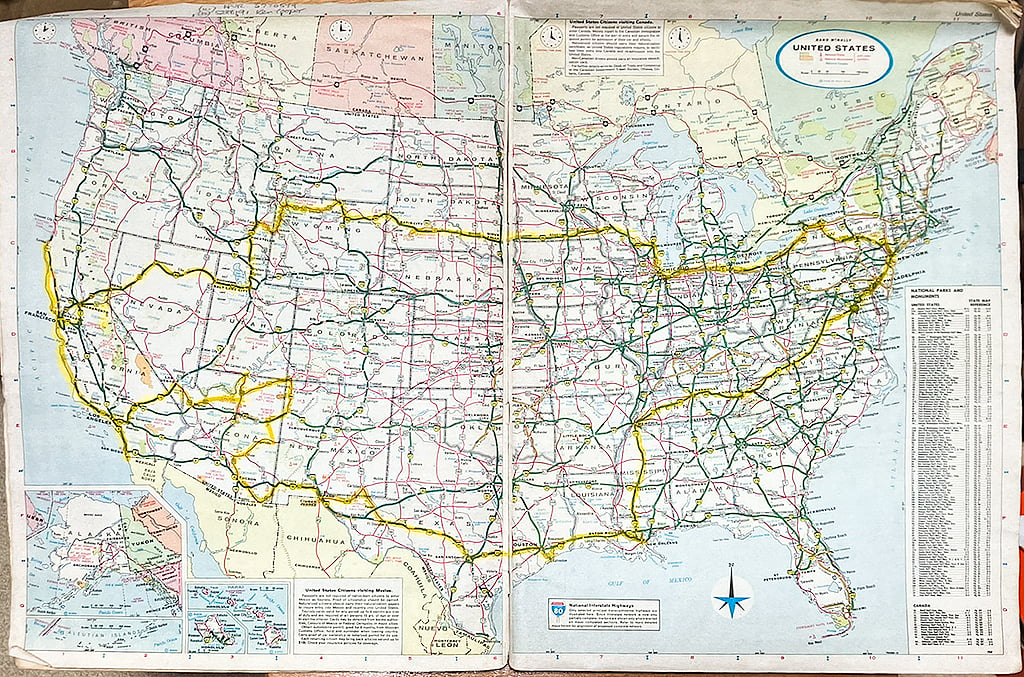
https://www.rangefinderforum.com/gallerysoft/gallery/27021/U27021.1700629148.0.jpg
(map added by Moderator Doug at OP's request)
A note about the photos
It was only in November 2023 - 44 years later - that I got around to scanning most of the slides. In the intervening years a small number have gone missing, though thankfully the more memorable pictures have survived. At least I established a file naming system from the outset: USA#roll_number-#frame_number eg USA01-15. At time of writing I’ve scanned over 1,800 slides on my Epson V700 at 4800 dpi, which will now need post processing in Lightroom. I’ll keep working on them as I add to this thread.
The next question was how to get around once there. Fortuitously there was an adventure travel company located above the travel agency, and it didn’t take much persuading to book an around-America camping/adventure trip lasting 6 weeks. That gave me 3 weeks to do some independent travel before my return flight to Australia.
My camera at the time was a Nikon FM with three primes: the 35mm f/2.8, 50mm f/1.4 and 105mm f/2.5. Film choice was easy: I decided on my favourite colour emulsion Kodachrome 25.
And so to Sydney’s Kingsford Smith airport on the day of departure in early May 1979, feeling very excited. I needed to buy duty free film on the way. Being cautious I checked the unloaded camera in the car only to discover it had jammed when I tried to cock the shutter. The flight was due to depart in three hours. Panic.
I detoured to the Nikon importer’s service centre to see if it was a quick fix. They were sympathetic but nothing could be done before my flight. My only option was to buy a new body. At least I could buy it duty free.
At the duty free store I decided on a new Nikon FE. I also bought 60 rolls of Kodachrome 25/36, an amount which amazed the sales assistant. I asked him to pack the film into lead lined X-ray protective pouches before he sealed the camera and film into a duty free bag (which could only be opened once through the Customs barrier at the airport)*. Sealed bag in hand I rushed to make my flight, glad to make it in time after the unexpected detour and delays.
I met a young woman at the boarding gate. She was about my age, with an American accent, and her name was Karen. She turned out to be booked on the same trip I was. We boarded our flight and the adventure began.
*It wasn’t until much later that I realised the sales receipt only included the camera. The film gods were smiling that day.

https://www.rangefinderforum.com/gallerysoft/gallery/27021/U27021.1700629148.0.jpg
(map added by Moderator Doug at OP's request)
A note about the photos
It was only in November 2023 - 44 years later - that I got around to scanning most of the slides. In the intervening years a small number have gone missing, though thankfully the more memorable pictures have survived. At least I established a file naming system from the outset: USA#roll_number-#frame_number eg USA01-15. At time of writing I’ve scanned over 1,800 slides on my Epson V700 at 4800 dpi, which will now need post processing in Lightroom. I’ll keep working on them as I add to this thread.
Last edited by a moderator:
lynnb
Mentor
#USA01-09. Trans Pacific flight on Pan Am, May 1979. I spent most of the flight watching the clouds out the window.
Nikon FE Nikkor 35mm f/2.8 Kodachrome 25 polariser V700 LR6
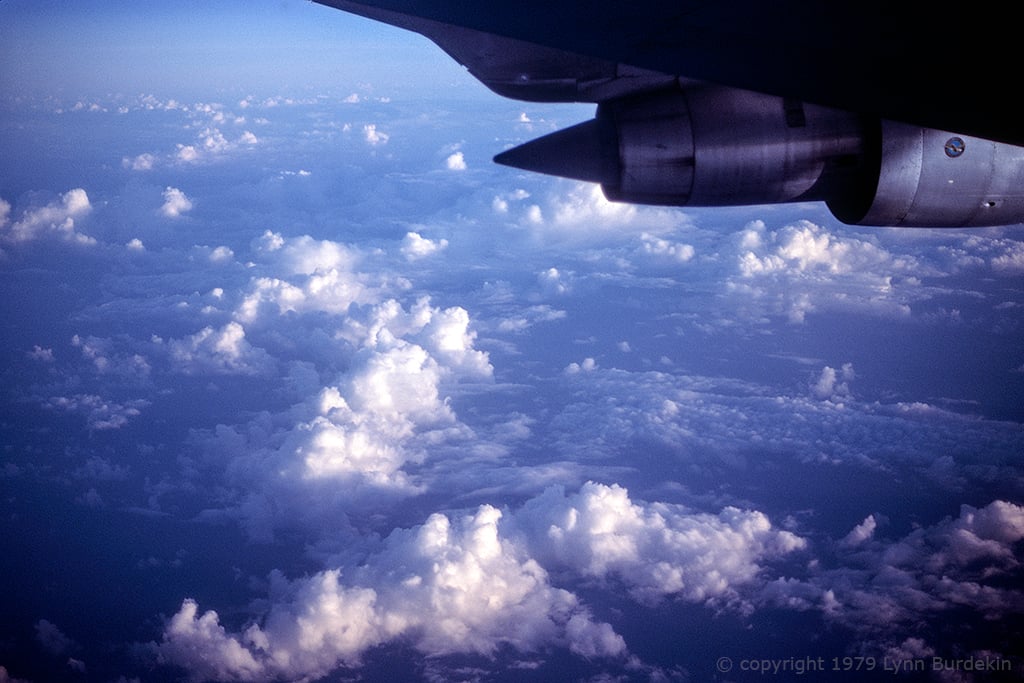
Nikon FE Nikkor 35mm f/2.8 Kodachrome 25 polariser V700 LR6

Last edited:
lynnb
Mentor
#USA01-13. Cab ride from the airport motel to downtown LA, May 1979.
I was immediately struck by the size of the cars and the size of the freeways compared to my home town of Sydney.
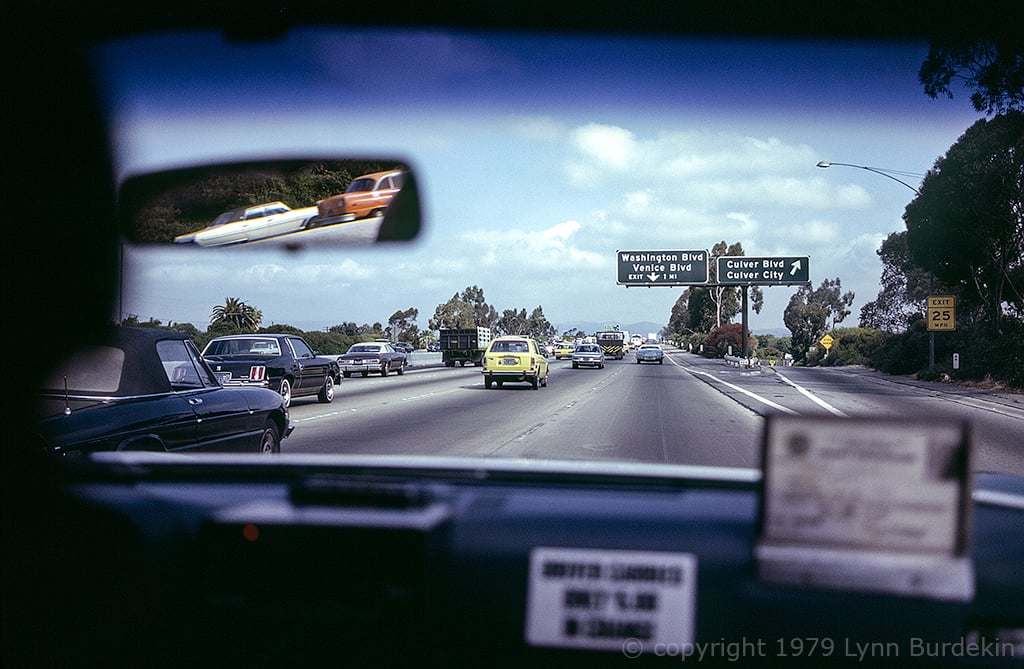
I was immediately struck by the size of the cars and the size of the freeways compared to my home town of Sydney.

lynnb
Mentor
#USA01-16. Approaching downtown LA in a cab, May 1979
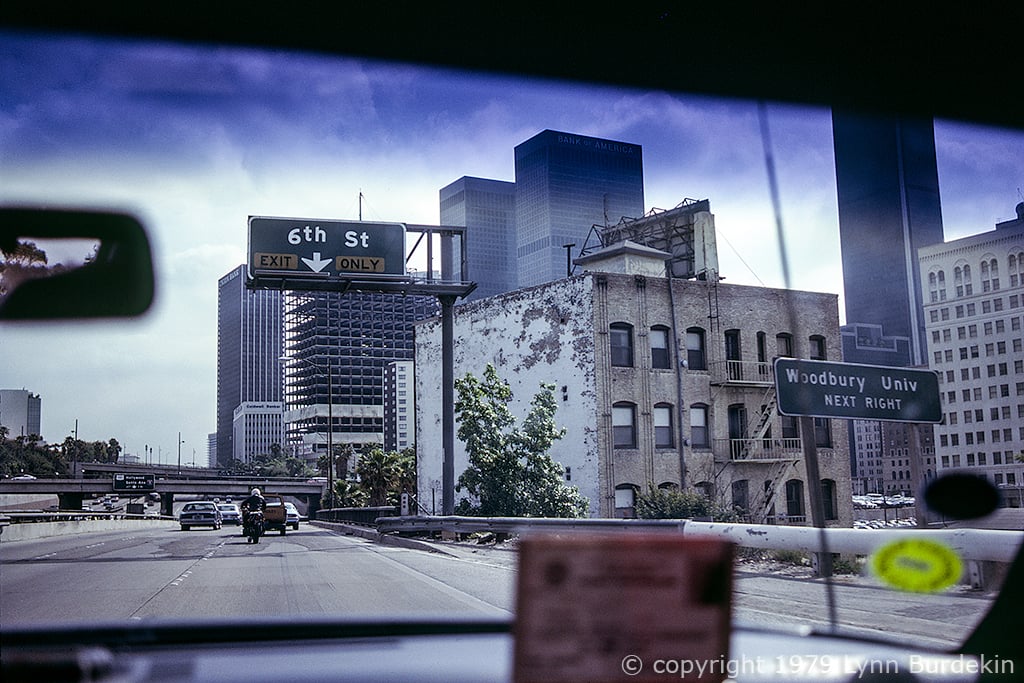

lynnb
Mentor
#USA02-01. Hollywood and Vine, 01 May 1979
This guy made the peace sign when he saw me about to take the picture. Welcome to LA, I thought.
Nikon FE Nikkor 35mm f/2.8 Kodachrome 25 V700 LR6
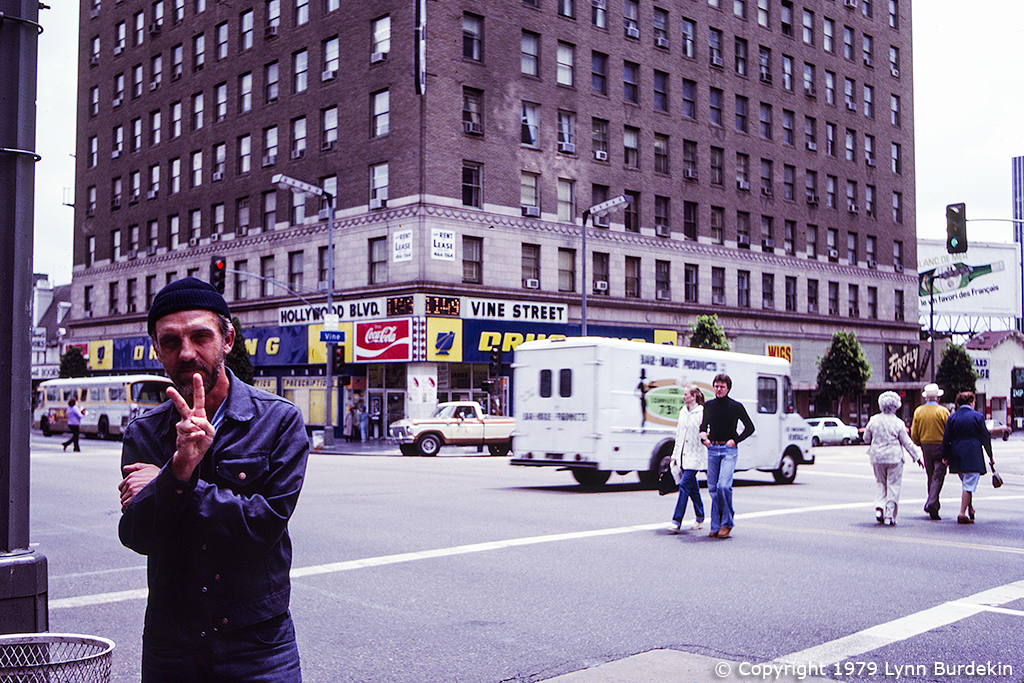
This guy made the peace sign when he saw me about to take the picture. Welcome to LA, I thought.
Nikon FE Nikkor 35mm f/2.8 Kodachrome 25 V700 LR6

Last edited:
lynnb
Mentor
#USA01-19. Downtown LA, 01 May 1979.
I had never seen a city like this. The wide streets and office blocks in the downtown area seemed impersonal, unlike Sydney with its narrow streets and crowded sidewalks where people-watching was easy.
![U27021.1699613713.0.jpg[IMG]](https://www.rangefinderforum.com/gallerysoft/gallery/27021/U27021.1699613713.0.jpg[IMG])
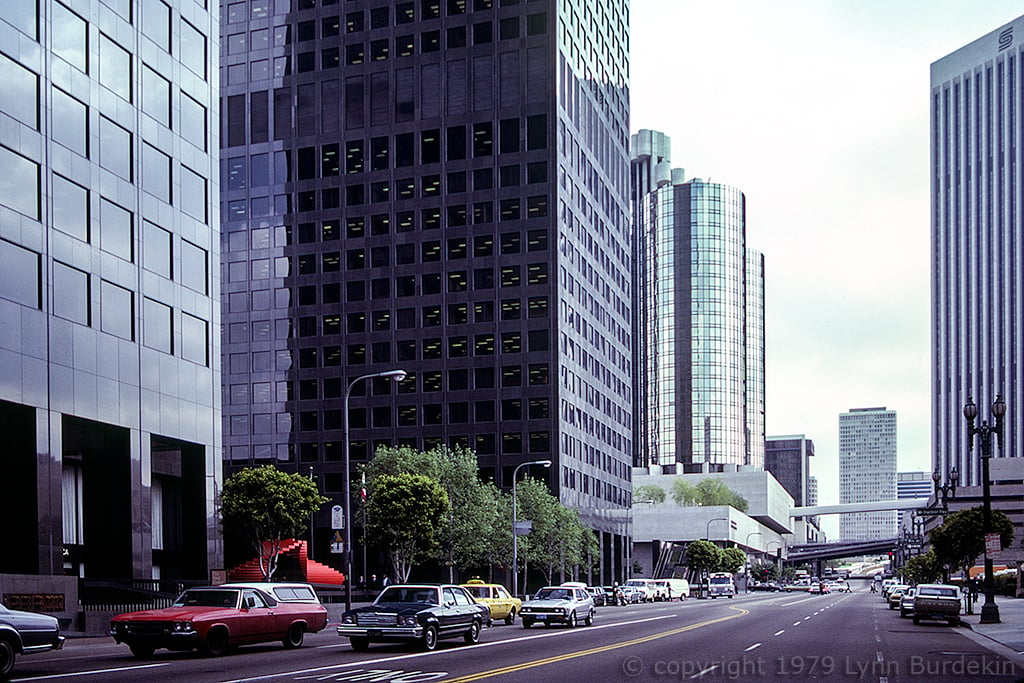
I had never seen a city like this. The wide streets and office blocks in the downtown area seemed impersonal, unlike Sydney with its narrow streets and crowded sidewalks where people-watching was easy.
![U27021.1699613713.0.jpg[IMG]](https://www.rangefinderforum.com/gallerysoft/gallery/27021/U27021.1699613713.0.jpg[IMG])

Last edited:
lynnb
Mentor
USA01-21. LA Bonaventure, 01 May 1979.
Impressive modernistic architecture, I had to have a look inside.
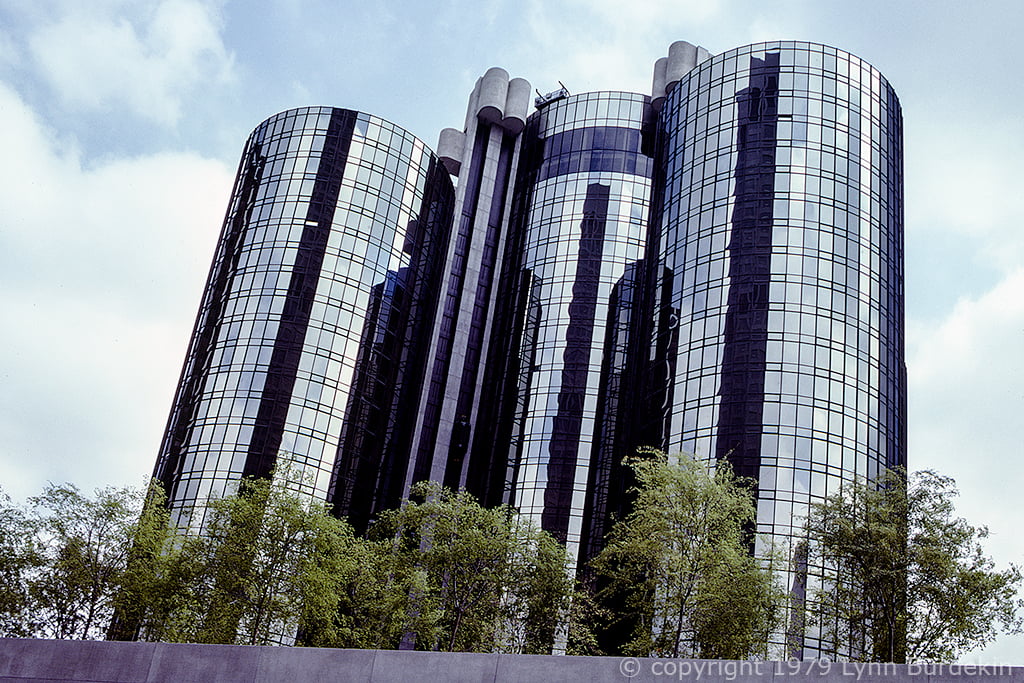
Impressive modernistic architecture, I had to have a look inside.

Last edited:
lynnb
Mentor
#USA01-22. Downtown LA, 01 May 1979
Although the slides are in overall great condition, I have some difficulty getting the scanned images' colour balance right in post. The originals have a slight magenta/blue cast. I've done the best I can. I think I may have adjusted this too far towards green.
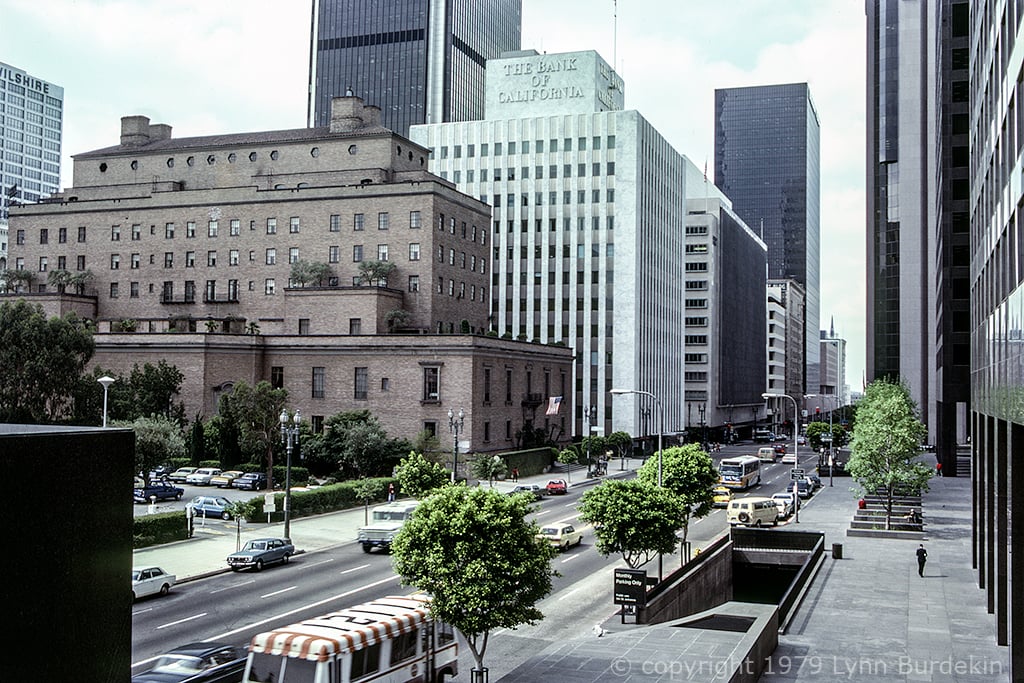
Although the slides are in overall great condition, I have some difficulty getting the scanned images' colour balance right in post. The originals have a slight magenta/blue cast. I've done the best I can. I think I may have adjusted this too far towards green.

Last edited:
lynnb
Mentor
#USA01-34. LA, 01 May 1979.
This is more like it, an alive city with lots of people going about their lives. The cross street sign says Hill St. The newspaper dispensing machines were a novelty to me. The fire hydrants were familiar from American TV shows and movies.
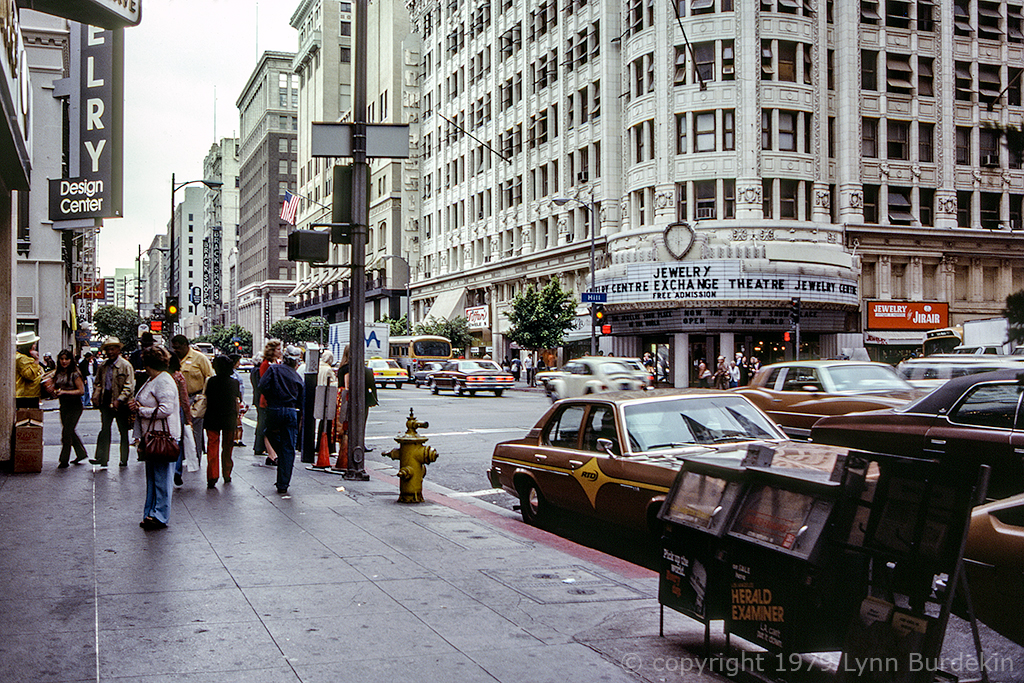
This is more like it, an alive city with lots of people going about their lives. The cross street sign says Hill St. The newspaper dispensing machines were a novelty to me. The fire hydrants were familiar from American TV shows and movies.

Last edited:
lynnb
Mentor
#USA01-33. LA, 01 May 1979.
Note the historic KRKD radio tower in the background. This is more like how I expected an American city to look and feel like. All my expectations were based on American TV shows.
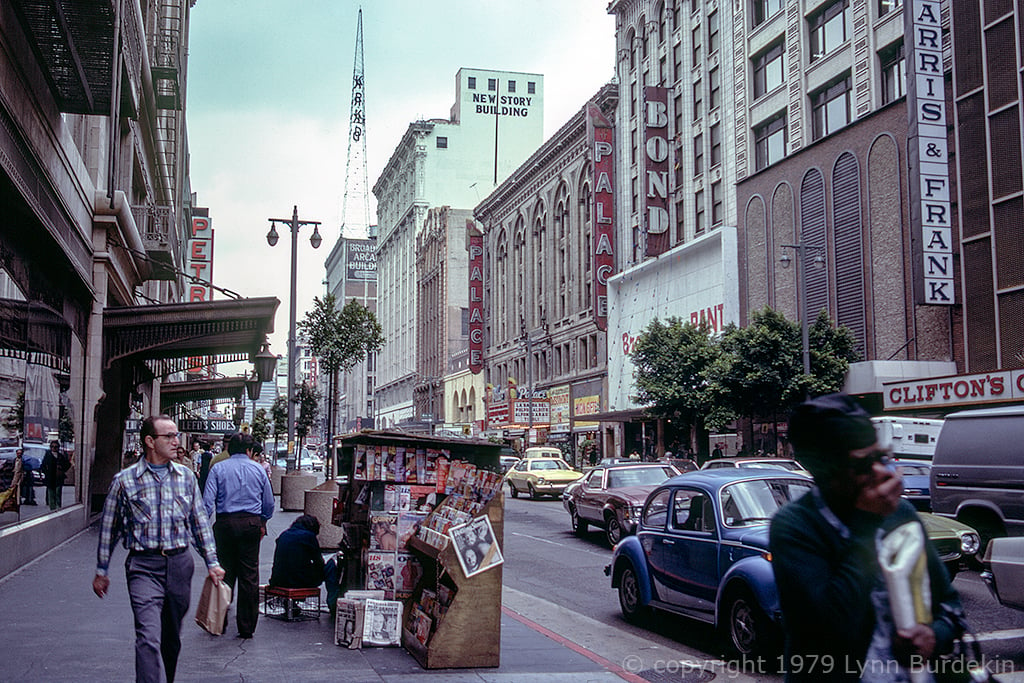
Note the historic KRKD radio tower in the background. This is more like how I expected an American city to look and feel like. All my expectations were based on American TV shows.

Last edited:
dave lackey
Mentor
Wow! 1800 slides, that is a massive amount of scanning and post-processing, Lynn!
I am in awe of your ability to actually do that! I am also delighted that you are doing it and I cannot wait to your posts.
This is remarkable. And I say that because it is true and nothing, not even my personal anguish and sorrow (long story), can deny that!
You definitely put a smile on my face!😃😃😃
Long live the FE!
I am in awe of your ability to actually do that! I am also delighted that you are doing it and I cannot wait to your posts.
This is remarkable. And I say that because it is true and nothing, not even my personal anguish and sorrow (long story), can deny that!
You definitely put a smile on my face!😃😃😃
Long live the FE!
lynnb
Mentor
Thanks Dave! It's kept me very busy the last few weeks. The scan files are around 175Mb each and total storage so far is just over 271Gb. It will be probably be up to 1.5x that when I've created the post processed TIFF files (I won't post process every file, only the notable ones).Wow! 1800 slides, that is a massive amount of scanning and post-processing, Lynn!
I am in awe of your ability to actually do that! I am also delighted that you are doing it and I cannot wait to your posts.
This is remarkable. And I say that because it is true and nothing, not even my personal anguish and sorrow (long story), can deny that!
You definitely put a smile on my face!😃😃😃
Long live the FE!
I'm having some difficulty with the colour balance in post, but that will improve with practice. Most of the slides seem to have a slight magenta cast especially in the shadows.
I'm glad I can put a smile on your face. You deserve a bit of happiness. Take care, and take pictures
lynnb
Mentor
#USA01-23. LA Bonaventure, 01 May 1979
The interior of the LA Bonaventure hotel impressed me with its futuristic design.
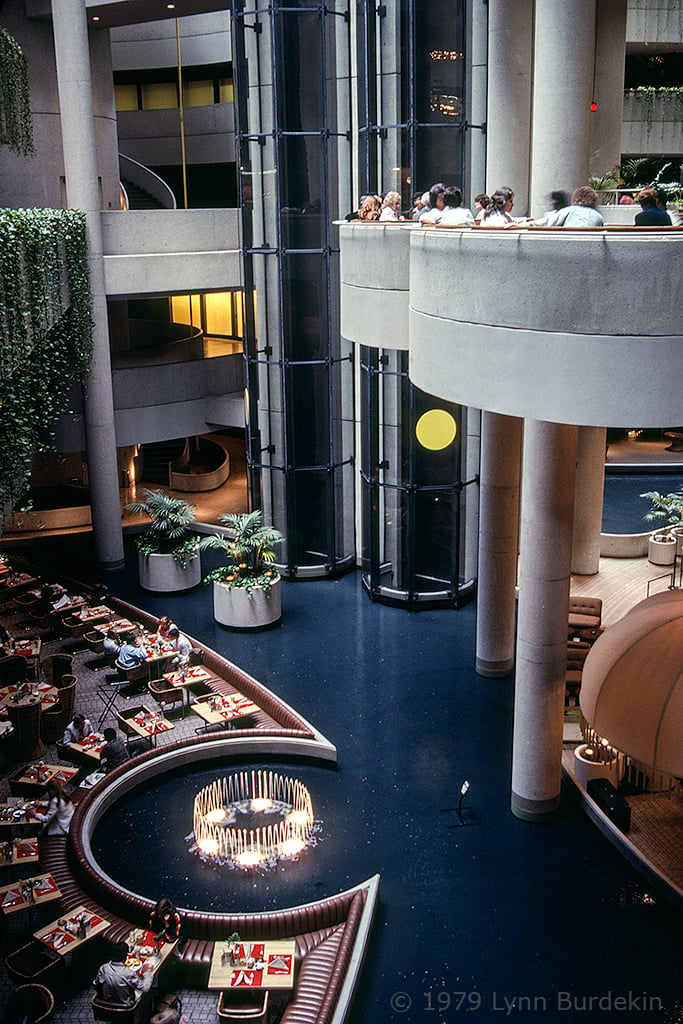
The interior of the LA Bonaventure hotel impressed me with its futuristic design.

lynnb
Mentor
#USA01-28 LA from the Bonaventure building, 01 May 1979
In 1979 LA seemed built for the motor vehicle. The original scan had a magenta cast; I adjusted it with auto tone in CS6. The result looks more natural but perhaps a little cool.
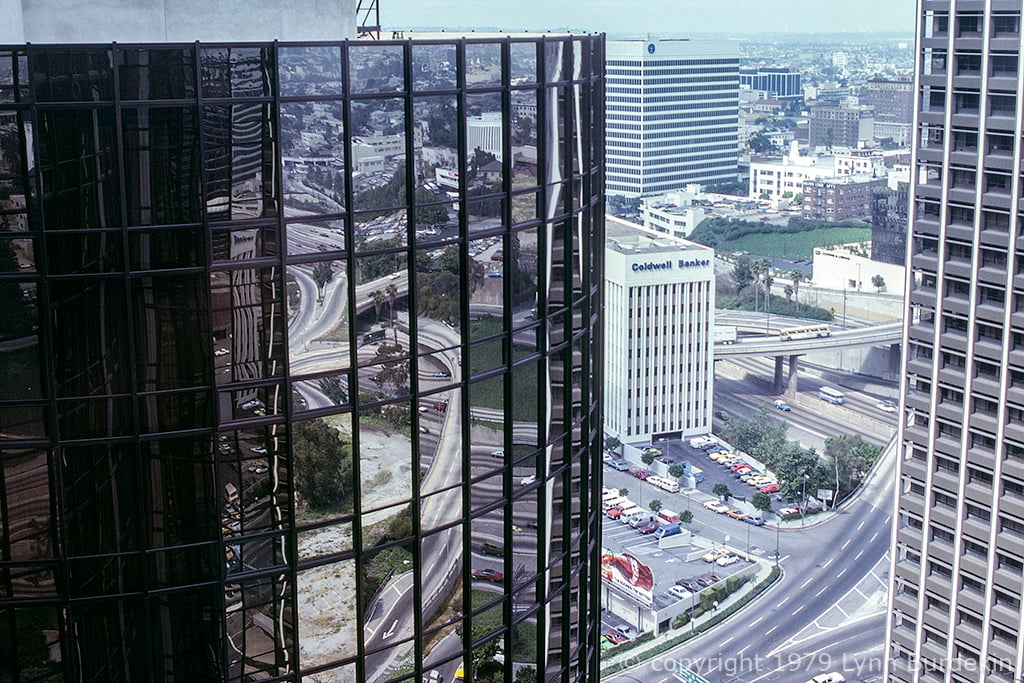
In 1979 LA seemed built for the motor vehicle. The original scan had a magenta cast; I adjusted it with auto tone in CS6. The result looks more natural but perhaps a little cool.

lynnb
Mentor
#USA01-29. LA from the Bonaventure building, 01 May 1979
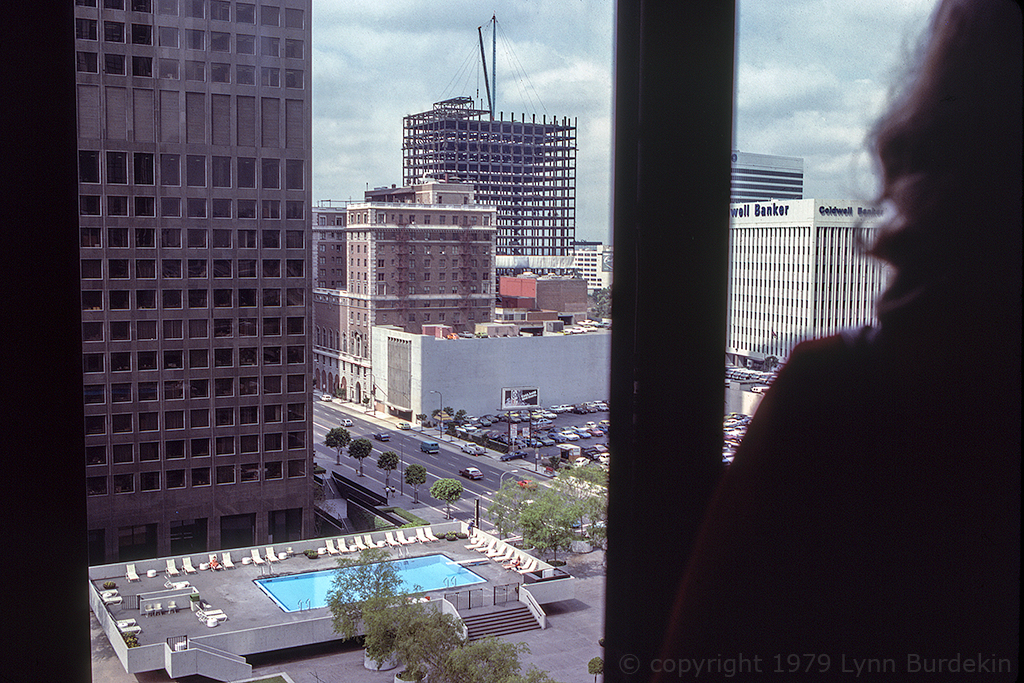

Dogman
Mentor
Impressive, Lynn. And what a great story of the beginning of your adventure!
raydm6
Yay! Cameras! 🙈🙉🙊┌( ಠ_ಠ)┘ [◉"]
Evergreen States
Pierre Saget (they/them)
Even many Americans believe that American cities are built for the car. But in reality, they were destroyed for the car. At one time, Los Angeles had the most extensive tram network in the world. All of it was dismantled as cars gained prominence, middle class white people were offered subsidies to move to suburbs and American infrastructure priorities shifted wholesale to accommodate suburban commuters to and rom the cities by car. This entailed the demolition of working class Black, Latine and Jewish neighborhoods for the construction of freeways into the hearts of downtown. Part of downtown L.A. used to be the working class Bunker Hill neighborhood.#USA01-28 LA from the Bonaventure building, 01 May 1979
In 1979 LA seemed built for the motor vehicle.
Great thread, by the way. I'm eagerly looking forward to seeing you post more in here.
pyeh
Member of good standing
Really enjoying these, Lynn. Such rich colour and detail, as well as your usual good eye.
Zuiko-logist
Well-known
Love these. Please post more.
Share:
-
This site uses cookies to help personalise content, tailor your experience and to keep you logged in if you register.
By continuing to use this site, you are consenting to our use of cookies.

